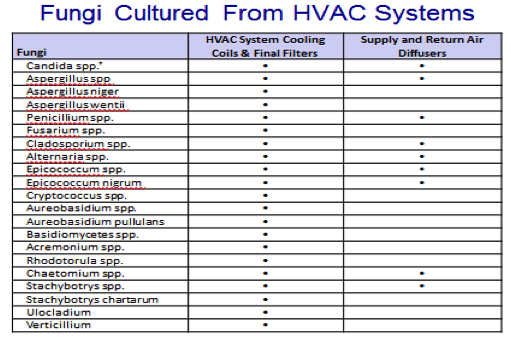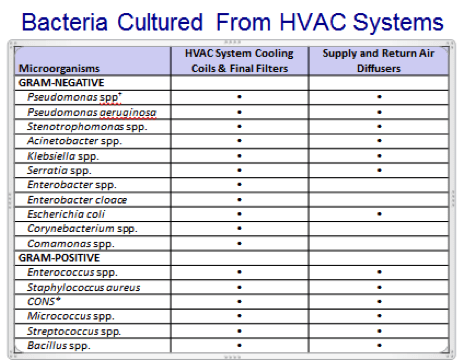Ultraviolet (UV) light is one form of electromagnetic energy produced naturally by the sun. UV is a spectrum of light just below the visible light and it is split into four distinct spectral areas – Vacuum UV (100 to 200 nm), UVC (200 to 280 nm), UVB (280 to 315 nm) and UVA (315 to 400 nm).
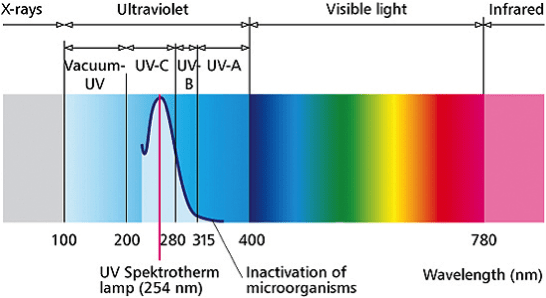
The entire UV spectrum can kill or inactivate many microorganism species, preventing them from replicating. UVC energy at 253.7 nanometres provides the most germicidal effect. The application of UVC energy to inactivate microorganisms is also known as Germicidal Irradiation or UVGI.
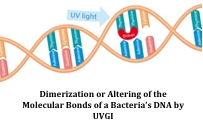 UVC exposure inactivates microbial organisms such as bacteria and viruses by altering the structure and the molecular bonds of their DNA (Deoxyribonucleic acid). DNA is a “blue print” these organisms use to develop, function and reproduce. By destroying the organism’s ability to reproduce, it becomes harmless since it cannot colonize. After UVC exposure, the organism dies off leaving no offspring, and the population of the microorganism diminishes rapidly.
UVC exposure inactivates microbial organisms such as bacteria and viruses by altering the structure and the molecular bonds of their DNA (Deoxyribonucleic acid). DNA is a “blue print” these organisms use to develop, function and reproduce. By destroying the organism’s ability to reproduce, it becomes harmless since it cannot colonize. After UVC exposure, the organism dies off leaving no offspring, and the population of the microorganism diminishes rapidly.
Ultraviolet germicidal lamps provide a much more powerful and concentrated effect of ultraviolet energy than can be found naturally. Germicidal UV provides a highly effective method of destroying microorganisms.
Some people call it dirt. Some call it mud, slime or sludge. This gluey matrix growing on heating, ventilating and air conditioning (HVAC) evaporator coils, drain pans and ducts is, in fact, biofilm. Biofilm is an active, complex microbial matrix of mold and bacteria that adheres to the fins of the coil and protects the organisms from biocides.
The biofilms themselves give off products of metabolism known as volatile organic compounds (VOCs) which may range in effects from watery eyes and headaches, to more severe allergy and asthma responses.
Numerous studies have demonstrated that the HVAC system is a viable amplifier, reservoir and disseminator of pathogenic and opportunistic bacteria, viruses and mold. The list below identifies some of the many microorganisms that have been isolated from evaporator coils, drain pans, ducts, final filters and diffusers.
No matter how good the coil cleaner, sprayer or pressure washer used, the effectiveness of these methods reaches about 1 inch into the coil and the organic and biologically active matter gets packed deeper into the coil fins.
Installed on air effluent side of the condensate cooling coils and the drain pan, Steril-Aire UVC energy destroys surface biofilm and airborne microorganisms before they circulate throughout the HVAC system.
The quality of indoor air, influenced by the levels of bioaerosols, contaminants and pollutants, can affect occupant health and development, resulting in reduced productivity and increased absenteeism. The biofilms themselves give off products of metabolism known as volatile organic compounds (VOCs) which can trigger occupant complaints of watery eyes and headaches and even severe allergy and asthma responses. The biological contaminants typically found on HVAC coils and drain pans have also been linked to Sick Building Syndrome (SBS) and hospital acquired infections.
Yes! Reading above tells you there is a biofilm growing on the fins of every cooling coil, causing heat exchange inefficiencies, capturing and proliferating molds, bacterias and viruses that are released downstream into your air, causing allergy, asthma systems as well as hospital acquired conditions and large expenditures of money for no reason.
The C wavelength of the UV spectrum targets the DNA of microorganisms, destroying their cells and making replication impossible. Directed at a cooling coil or drain pan, UVC energy destroys surface biofilm, a gluey matrix of microorganisms (bacteria, fungi, debris, et al.) that grows in the presence of moisture. Biofilm is prevalent in HVAC systems and leads to a host of indoor air quality (IAQ) and HVAC operational problems that are sometimes mistakenly attributed solely to mold. UVC also destroys airborne viruses and bacteria that circulate through an HVAC system.
By applying the power of UVC at the source of contamination – the HVAC evaporator coils and drain pan – Steril-Aire UVC destroys the reservoir of microorganisms. Without the ability to reproduce, microorganisms become inactive and harmless. The recirculating air in HVAC systems creates redundancy in exposing microorganisms to UVC, ensuring multiple passes so the light energy is effective against large quantities of airborne microorganisms. Steril-Aire UVC delivers the highest UVC output, driving HVAC system efficiency while improving indoor air quality.
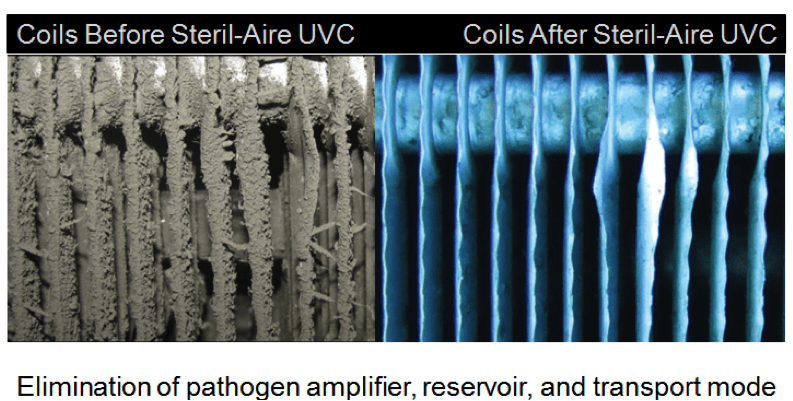
Steril-Aire Emitters have a unique chemical formula that when coupled with our engineered power supply create the highest in the industry UV-C output in a cold moving air stream.
Yes, by starving the colony forming units of food, the organisms can no longer survive and die. Over time, the colony forming units are dead and the air ducts are free of microbial output inot the airstream. This occurs by treating the source of the colony forming units in the air ducts, the cooling coil and the bio-burden it produces, Kill it at the source, and the rest is taken care of…
Yes, there are several case studies documenting the savings. See below for details. We see a 10 to 15% savings in energy when applied across all cooling coils in a facility.
Biological fouling of evaporator fin and tube heat exchangers is a key contributor to decreased HVAC capacity. The biological fouling acts as an insulator, increasing air flow resistance and decreasing heat transfer. The fans run longer to maintain the building at the desired temperature, increasing kW draw with reduced cooling tonnage capacity. A mere 10% increase in fan motor run can significantly increase energy use. The chillers and pumps work harder to raise the leaving water temperature and achieve set temperature points. For each degree the water temperature is increased, a savings of 1-2% will be realized.
Steril-Aire high output UVC provides continuous cleaning of coils, eliminating the biofilm that causes reductions in operational efficiency. Studies have shown that removal of a .024” layer of biofilm can reduce HVAC energy usage by 21% by restoring heat transfer and system efficiency. Reduced cooling coil pressure drop helps save fan energy, while improved cooling coil heat transfer efficiency. Higher chilled water temperature setpoints allows the chiller plant to operate more efficiently.
Read how Steril-Aire customers have improved system efficiency and achieved energy savings.
Click here for the white paper “How Steril-Aire UVC Can Cut Energy and Operational Costs”
The use of Steril-Aire UVC may contribute to LEED points across multiple project types in one or more of the following areas:
- Energy and Atmosphere
- Water Efficiency
- Indoor Environmental Quality
- Innovation & Design Process
- Regional Priorities
A 10,000 square foot building can produce more than 15,000 gallons of condensate water per year. Typically, this condensate is wasted and diverted to sewer systems. In order to effectively repurpose HVAC condensate, it must be free of biological components. Using Steril-Aire’s patented installation methodology and high output UVC directed at the cooling coil and drain pan, the condensate is distilled and clean. The condensate can be effectively collected for use as cooling tower makeup water or for gray water uses.
Read how the University of Delaware has saved water and energy costs with Steril-Aire UVC. Click here for the white paper “UVC Saves HVAC Water, Energy and Chemical Use”
Energy savings (10-15%), maintenance savings (no more ½ day to full day coil cleaning once per year as recommended by the coil mfg. No more drain pan tabs) productivity gains from the employees as the allergy/asthma symptoms are greatly reduced, absenteeism decreases in schools allows for more federal dollars to the school, increased life of the cooling coil as the biofilms eat away at the fins of the coil and copper connections, water savings if drain pan water is captured and utilized – case studies shows), etc.
Manual coil cleaning can be a major HVAC maintenance expense and may be very difficult to perform on small, tough-to-access packaged or unitary systems. Manually cleaning only temporarily removes the contaminants and in most cases, simply pushes the biological contaminants further back into the fins.
Steril-Aire UVC solves these problems by eliminating the need for chemical cleaning or pressure washing of any size coil. It also eliminates the associated downtime and inconvenience. Maintenance crews and building occupants are no longer exposed to harmful cleaning chemicals and disinfectants.
The surface cleaning effects of UVC helps restore older HVAC system to efficient operation and maintain new systems at factory design efficiency, while protecting system components against the acids that are emitted from the biofilm and the corrosive effects of chemical coil cleaning.
No, UVC does not kill dirt. It does clean the dust and dirt from the cooling coil as the biofilm releases its grip on the fins of coil and is washed ut the drain pan. But a good filter regimen is required to ensure the dust particles are captured and not released into the air stream, creating a less than desirable indoor air quality situation.
Typically on the downstream side of the coil over the drain pan if possible. If not possible due to system design constraints, install on the upstream side if possible. Last resort is in the air ducts as placement in the air ducts only produces fly-by kill, which is very difficult to accomplish due to the time and intensity needed to alter the DNA of micro-organisms. It is also not treating the cooling coil and source of the issues, and the related savings are forfeited.
To keep coils clean and free of biofilm and other buildup, a high-output UVC-light source should be positioned perpendicular to the fins of the coil and 12 in. off the discharge coil face. When using high-output lamps to eliminate contamination from an existing system, a 24-in. centerline is recommended. With new systems, the centerline may extend to 30 in.
Typically not, especially with our new Rapid Install Kit. (See attached Cut Sheet. It is sized for each specific air handler and takes less than one hour to install a three row system or smaller. Other systems typically call for a one-inch hole to be drilled in the side of the unit, two self-tapping screws to mount the fixture, install the bulb, attached the 120V cord included and plug in. See the Bay Motor website for a video demonstration with a new user and his dog. Easy!
Output is critical because it affects a UVC lamp’s performance. To effectively clean coils and eliminate biofilm, a UVC device should provide output measure at a minimum of 9 µW/cm2 per inch of glass from a distance of 1 meter, when tested in a 400 fpm airstream at 50 °F.
Steril-Aire has developed a UVC Application Standard that includes technical data and specifications, as well as installation, sizing, dosage and other guidelines to assist in the proper selection and application techniques of UVC lamp systems.
No need to and waste of money. Steril-Aire UVC systems will do all the cleaning for you.
You will have a fresher, cleaner smell in your building in about two to three days, you can take before and after pictures, there are petri-dishes available for purchase to compare before and after installation samples, we have coil swabs that can be processed to determine the speciation and quantity of the microbes on the surface of the coil before and after Steril-Aire installation, you can measure the pressure drop across the cooling coil before and after, which is a mechanical measurement showing the reduction in clogging of the coil, you can measure the wet bulb/dry bulb readings of the coil before and after (another mechanical measurement), and you can measure the CFM air flow before and after installation (another mechanical measurement). The mechanical measurements when input properly in a calculation reflect the enthalpy of a system, or the cooling capacity and bthu use of a unit. When the S.P. (static pressure) drops and the WB/DB separate and the CFM increases, the bthu usage decreases and you save energy dollars. Simple.
Two ways:
- The half-life of our lamps is 9,000 hours. At this timing, the effectiveness of our lamps has dropped and becomes ineffective in maintaining a microbial kill on and in the cooling coil. Thus, change the lamps every 9,000 hours which is approximately one year.
- Secondly, using a Radiometer, one can determine the UVC intensity (microwatts per centimeter squared) on the surface of the coil at various places and average the results. This will determine if there is enough intensity to continue to control the microbes you are wanting to control in your AHU system. Documented tables show the time and intensity needed to take care of microbes before they replicate and grow. If the intensity falls below that level, change the emitters. System design is critical in this area especially if certain specifications must be met from engineers/similar occupations or in critical care environments in hospitals.
Typical UVC issues occur when the eyes are not properly protected with safety glasses and the skin is exposed. The eyes receive a welder’s flash and is treated with salve, ice packs and time, approximately 24 hours. The skin is a bad sun burn so treat as such. No known longer term effects have been documented.
No, Steril-Aire devices do not produce ozone or other secondary contaminants. According to the U.S. EPA, “Recovery from the harmful effects can occur following short-term exposure to low levels of ozone, but health effects may become more damaging and recovery less certain at higher levels or from longer exposures (US EPA, 1996a, 1996b).”
In critical care applications, process lines and clean rooms, etc…and warmer environments the lamps should be run 24/7, 7 days per week. This ensures the coils inside and out are continuously cleaned. In areas where winter is a six month issue, lamps can be idled for a period of time. However, this will allow for any microbial growth to flourish in the system if introduced in any way.
Again, intensity is key. The level of UVC after one year on any lamp should be suspect, two years virtually useless for microbial control. Beyond that you are back to wasting energy by keeping the lamps burning.
Typically no cleaning is necessary. The water that sometimes blows off the coil is caused by dirty coils. Once this is taken care of, there is no blow over and the lamps remain dry. If they are off for an extended amount of time, lamp cleaning with an alcohol wipe may be needed.
Dispose of them as you would any fluorescent tubes, in compliance with your country, local or state codes.
Emitter lamps have a one year (9,000 hours) warranty if not broken. Fixtures and power supplies have a 5 year warranty.
